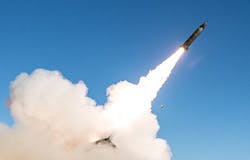Lockheed Martin to build rocket artillery with satellite and inertial guidance and fire-control electronics
Questions and answers:
- What is the purpose of the M270A2 GMLRS system? It provides precision long-range artillery fire support using guided rockets to strike enemy targets as far away as 93 miles.
- What improvements does the M270A2 have over previous versions? It includes the Common Fire Control System, a new engine, transmission, armored cab, and improved launcher-loader modules.
- What types of munitions can the GMLRS system fire? It can fire Guided MLRS rockets, Army Tactical Missile System (ATACMS) missiles, Precision Strike Missiles (PrSM), and Extended-Range GMLRS rockets.
REDSTONE ARSENAL, Ala. – Artillery fire support experts at Lockheed Martin Corp. will build M270A2 Guided Multiple Launch Rocket Systems (GMLRS) field artillery systems for the U.S. Army under terms of a $4.2 billion order announced Thursday.
Officials of the Army Contracting Command at Redstone Arsenal, Ala., are asking the Lockheed Martin Missiles and Fire Control segment in Grand Prairie, Texas, to produce the GMLRS rocket artillery, which will fire MLRS rockets, Army Tactical Missile System (ATACMS) missiles, and the Army's future Precision Strike Missile (PrSM) and Extended-Range GMLRS rockets.
GMLRS is a heavy tracked mobile munitions launcher, transportable via C-17 and C-5 aircraft. The M270A2 is an upgraded variant of the Lockheed Martin M270 MLRS. The A2 version features the Common Fire Control System (CFCS), as well as new engine, transmission, launcher-loader modules, and improved armored cabs.
GMLRS smart munitions will have three variants: the Guided MLRS Unitary; Guided MLRS Alternative Warhead; and the Extended-Range Guided MLRS. Army spending on the GMLRS thus far is $13.3 billion.
GMLRS explosive warheads
The unitary GMLRS munition has a unitary warhead to provide precision strike for point targets as far way as 44 miles. the GMLRS Alternative seeks to avoid the effects of unexploded ordnance, and has a 200-pound fragmenting warhead for targets as far away as 44 miles. The Extended-Range GMLRS round can hit targets as far away as 93 miles, using a large motor and tail-driven enhanced maneuverability.
The M270A2 is an upgraded variant of the Lockheed Martin M270 MLRS. The A2 version features the Common Fire Control System (CFCS), as well as new engine, transmission, launcher-loader modules, and improved armored cabs.
The CFCS will be common to the Army MLRS and to the High-Mobility Artillery Rocket System (HIMARS). The CFCS will help enable the MLRS to fire the extended-range GMLRS munition, which has a range of nearly 94 miles, and is expected to see future upgrades in sensors, propulsion, and navigation.
GMLRS electronic subsystems primarily are part of the launcher's fire-control system -- the core electronics that controls the launch sequence, and monitors, coordinates, and manages all electronic devices during launch.
Tell me more about artillery fire support ...
- Artillery fire support uses cannons, rocket artillery, and missiles to support friendly forces by suppressing or destroying enemy forces using indirect fire directed from behind front lines by forward observers who identify targets, calculate firing data, and adjust fire as needed. Artillery fire support greatly enhances the combat capabilities of ground forces by enabling long-range, powerful strikes that can shape the battlefield, protect advancing troops, and degrade enemy fighting ability while minimizing friendly casualties. It is a critical element of combined arms operations in modern warfare.
The fire-control electronics consist of a fire control panel for data entry and display; the electronics unit that contains the computer program and data processing for calculating launch and ballistic parameters; the fire control unit that translates computer outputs to control signals; and boom controller that handles remote control of loading and positioning.
Other GMLRS electronics include a short/no-voltage tester to ensure safe electrical connections during loading; stabilization reference package and position determining system that provides heading, elevation, launcher slope, and position location data through gyroscopes and encoders; payload interface module that interfaces power and communications between the launcher and rockets.
Additional GMLRS electronics are the program load unit that programs and loads munition data to the fire-control computer; communications processor that handles the flow of coded messages for fire control and communications security; communications system like radios and crew intercom; and primary power supply that provides 24-volt power and manages power distribution.
The Army ordered the first 50 M270A2 upgrade kits through a $362 million contract in April 2019 with deliveries completed on that contract in 2022. The M270A2 GMLRS officially became operational with the U.S. Army in 2022.
Satellite and inertial guidance
GMLRS uses satellite and inertial guidance; and fires from the M270 MLRS and the M142 High Mobility Artillery Rocket System (HIMARS) from distances as far away as 50 miles, with extended ranges reaching as far as 95 miles.
Variants of the GMLRS include the relatively old M30 GMLRS with a submunition warhead; the M31 GMLRS with a unitary warhead; the GMLRS-AW with an alternative warhead for area effects; and the extended-range (ER) GMLRS with the weapon's longest range and best accuracy.
On this order Lockheed Martin will do the work at locations to be determined with each order, and should be finished by October 2027. For more information contact Lockheed Martin Missiles and Fire Control online at www.lockheedmartin.com/en-us/who-we-are/business-areas/missiles-and-fire-control.html, or the Army Contracting Command-Redstone at https://acc.army.mil/contractingcenters/acc-rsa/.
About the Author
John Keller
Editor-in-Chief
John Keller is the Editor-in-Chief, Military & Aerospace Electronics Magazine--provides extensive coverage and analysis of enabling electronics and optoelectronic technologies in military, space and commercial aviation applications. John has been a member of the Military & Aerospace Electronics staff since 1989 and chief editor since 1995.
